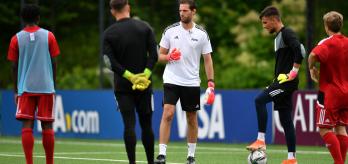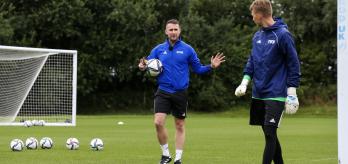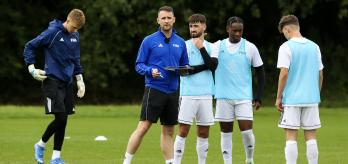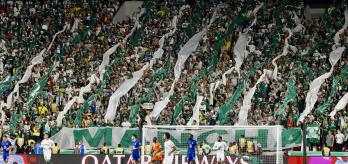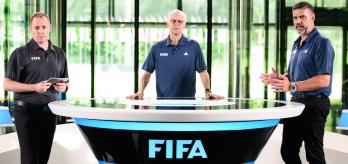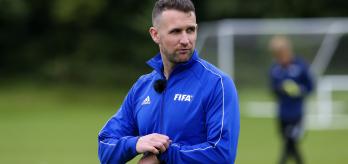The FA and England's Head of Coaching (and former Head of Goalkeeping), Tim Dittmer, offers a variety of goalkeeping drills that allow goalkeepers to gain a better understanding of how to defend space. Working with a group of four goalkeepers, the principal idea behind each exercise is to focus on 1v1 scenarios. Firstly, an exercise in which players work on defending the space at close range is introduced. The session then moves onto a ball rotation drill and then onto an exercise that focuses on leg and footwork. The session concludes with two further 1v1 scenarios, firstly working on goalkeepers closing down shooting angles and then on controlling the space from high positions.
Session overview
- Part 1: 2v2 small-sided game – defending the space
- Part 2: in possession – ball rotation in a diamond
- Part 3: 1v1 scenarios – leg and footwork
- Part 4: 1v1 scenarios – closing down shooting angles
- Part 5: 1v1 scenarios – balls through/over from distance
Key coaching points
- Implementing the "3-metre rule" allows goalkeepers to understand when they can try to win the ball and when they should hold their position.
- A low body posture and lowering of the hands when close to the attacker make it easier for the goalkeeper to smother the ball.
- A tall and upright posture allows goalkeepers to be prepared for shots from longer distances.
- A combination of these principles helps goalkeepers to be prepared for any type of 1v1 scenario.
This training session was devised with specific 1v1 scenarios in mind. When defending the space, can goalkeepers improve their chances of coming out on top by paying attention to the distance between themselves and the attacker? The objective is to give them specific postures and positions for specific distances/ranges.
Part 1: 2v2 small-sided game – defending the space
This small-sided game allows goalkeepers to focus on the fundamentals when defending 1v1 scenarios. Working on goalkeepers' decision-making and positioning is crucial to their success when in 1v1 situations. This exercise hones goalkeepers' awareness of when to stay or go and teaches them to adopt a posture to minimise the likeliness of conceding goals and maximise their chances of smothering or blocking shots.
-
Set up a small pitch that is 18 metres long and 12 metres wide. Use the image as a guide.
-
Mark a line 5 metres behind the goal (the “end line”).
-
Mark out a halfway line across the pitch.
-
Place a mini-goal at each end.
-
Place a mannequin behind each goal.
-
In this drill, 2 goalkeepers play against 2 goalkeepers.
-
In possession, the goalkeepers should try to score and can only use their feet.
-
Out of possession, the goalkeepers should try to win the ball back using their hands.
-
To score a goal, the goalkeepers can pass the ball into the mini-goal once they pass the halfway line.
-
They can also score by dribbling the ball to the end line.
-
Set a time limit of 10 seconds for goalkeepers to score in the goal or dribble the ball to the end line.
-
Allow goals scored from a goalkeeper’s own half to count.
-
A goal can be scored if the goalkeepers hit the mannequin behind the goal with the ball.
-
Finally, goalkeepers can still dribble the ball past the line to score but if they wish to score in the goal or by hitting the mannequin, they now have to do so with a first-time finish inside the opponents' half.
-
When defending the goal, goalkeepers should focus on distance and their body posture in relation to this distance.
-
If the attacking goalkeeper is 0-3 metres from them, then the defending goalkeeper should lower their stance and hands.
-
Paying attention to the position of their feet and ensuring that they are no more than shoulder width apart will help them to track and move quickly.
-
Goalkeepers should try to show the attacking goalkeepers onto the outside and be ready to dive down and smother the ball.
-
At the same time, goalkeepers should position their body to block off shots towards the goal and spread themselves across the goal if necessary.
-
When blocking shots, goalkeepers should focus on a low, wide and square posture.
-
When defending shots from distance, goalkeepers should adjust their bodies so that they are upright and standingtaller, but still ready to react.
Part 2: in possession – ball rotation in a diamond
By circulating a ball in a diamond shape and using defined spaces, this exercise allows goalkeepers to practise moving the ball between themselves and the centre-backs. The purpose should be for the goalkeepers to understand the necessary distance from the centre-back when providing support or playing out from the back, the passing angles that need to be created and how they can use the space in front of goal, as well as the footwork required, to move the ball effectively when under pressure. It also helps the goalkeepers to reposition themselves when their team lose the ball and to face shots inside the area during the transition.
-
Mark out a pitch with 2 goals, as shown in the image.
-
Mark the halfway line on the line of the penalty area.
-
Place two mannequins on the edge of the penalty area as shown in the image.
-
Mark out 4 boxes in front of each goal as shown in the image.
-
2 goalkeepers position themselves in opposing goals.
-
The other 2 goalkeepers should be split so one is alongside each mannequin, behaving as a centre-back, as shown in the image.
-
Sequence 1
-
Starting with the goalkeeper, the 4 players should pass the ball in rotation between themselves in a diamond shape.
-
The coach should observe and analyse the players, while allowing them to play freely.
-
Switch goalkeepers around so that they get to play both roles.
-
-
Sequence 2
-
The players should continue passing the ball between themselves in rotation, but some additional criteria apply.
-
The first goalkeeper to meet the following 6 criteria wins:
-
▪ Complete a 1-touch pass.
▪ Complete a 2-touch pass.
▪ Complete a pass from 1 of the front boxes.
▪ Complete a pass from 1 of the back boxes.
▪ Complete a pass from the "away" box (the far side).
▪ Complete a pass from the "near" box.
-
-
One pass can count for more than one criterion. For example, should a pass be a one-touch pass and be made from one of the front boxes, the player has met two of the criteria.
-
-
Sequence 3
-
The players should continue passing the ball between themselves in rotation while trying to meet the same criteria, with one additional constraint: the goalkeepers have to move the ball into another box when they receive it.
-
-
Sequence 4
-
The players should continue passing the ball between themselves in rotation, but the 6 criteria are taken away.
-
Add an extra player to press the other 4. This player can press however they choose.
-
-
Sequence 5
-
The players should continue passing the ball in rotation using the movements practised and an extra ball is added to the exercise.
-
The whistle signals that the player with the ball has to shoot at one of the goals; the goalkeeper should try to stop the shot.
-
The coach will give the extra ball to the other centre-back, who has to shoot towards the other goal. Again, the goalkeeper should try to block/save the shot.
-
-
The first sequence should be observed to understand what the players are doing correctly or incorrectly.
-
The players should consider how to use the distances and the boxes when receiving or passing the ball. They should also be imaginative with their movement.
-
When receiving and playing the ball, each player should focus on the quality of their touch and passing.
-
In sequence 2, the goalkeepers should move between each box and vary their play.
-
If the centre-back is close, the goalkeeper should go to the far box to create distance.
-
However, if the centre-back is further away, the goalkeeper should come to the near box to offer support and receive the ball.
-
The goalkeepers should work on shuffling their feet quickly to move the ball between boxes in sequence 3.
-
When being pressed in sequence 4, the goalkeepers should move between the boxes to ensure a good distance and angle are achieved in relation to the pressing player.
-
In sequence 5, a decision should be made about whether the goalkeeper should close down the shot or stay in goal.
-
If the distance is long, the goalkeeper should stay in goal and stand tall. Alternatively, if the attacker comes closer, the goalkeeper should close the distance and lower their posture/hands.
Part 3: 1v1 scenarios – leg and footwork
This exercise presents multiple 1v1 situations for goalkeepers to defend and work on their ability to react to unexpected scenarios and short through-balls. By focusing on their body positioning and alertness, the goalkeepers can give themselves a better chance when dealing with 1v1 scenarios, as well as rebounds. This exercise encourages them to take up a particular position and posture depending on the angle or position of the striker when lining up a shot.
-
Place a rebounder in front of the goal (about 8 metres out).
-
1 goalkeeper positions themselves in goal, with another behind the goal ready to alternate.
-
The other 2 goalkeepers support the coach on either side as strikers.
-
Play starts with the coach, who initiates a variety of 1v1 situations.
-
The defending goalkeepers take it in turns to protect the goal.
-
Playing the ball off the rebounder, the coach will then tee up a striker, who shoots. The goalkeeper tries to stop the shot.
-
The second goalkeeper (acting as a striker) can score from any rebounds.
-
Play continues until the ball is out of play or with the goalkeeper.
-
To keep the defending goalkeeper on their toes, the coach can mix it up by taking shots at goal.
-
The goalkeepers are required to be alert and prepared.
-
Positioning, repositioning and reacting to the striker’s movement are imperative to make saves.
-
The goalkeeper should adjust their positioning based on the striker’s position and shooting angle.
-
If the striker is angled towards the near post, the goalkeeper should lean with their chest and front leg whilst sticking their back leg out at the same time.
-
If the striker opens up to shoot towards the far post, the goalkeeper should shuffle across and spread themselves.
-
When facing the strikers, if the goalkeeper cannot get within 3 metres of them, they should stay in goal and narrow the angle.
-
The goalkeepers should be prepared for any rebounds, even if the rebounds fall to the coach.
Part 4: 1v1 scenarios – closing down shooting angles
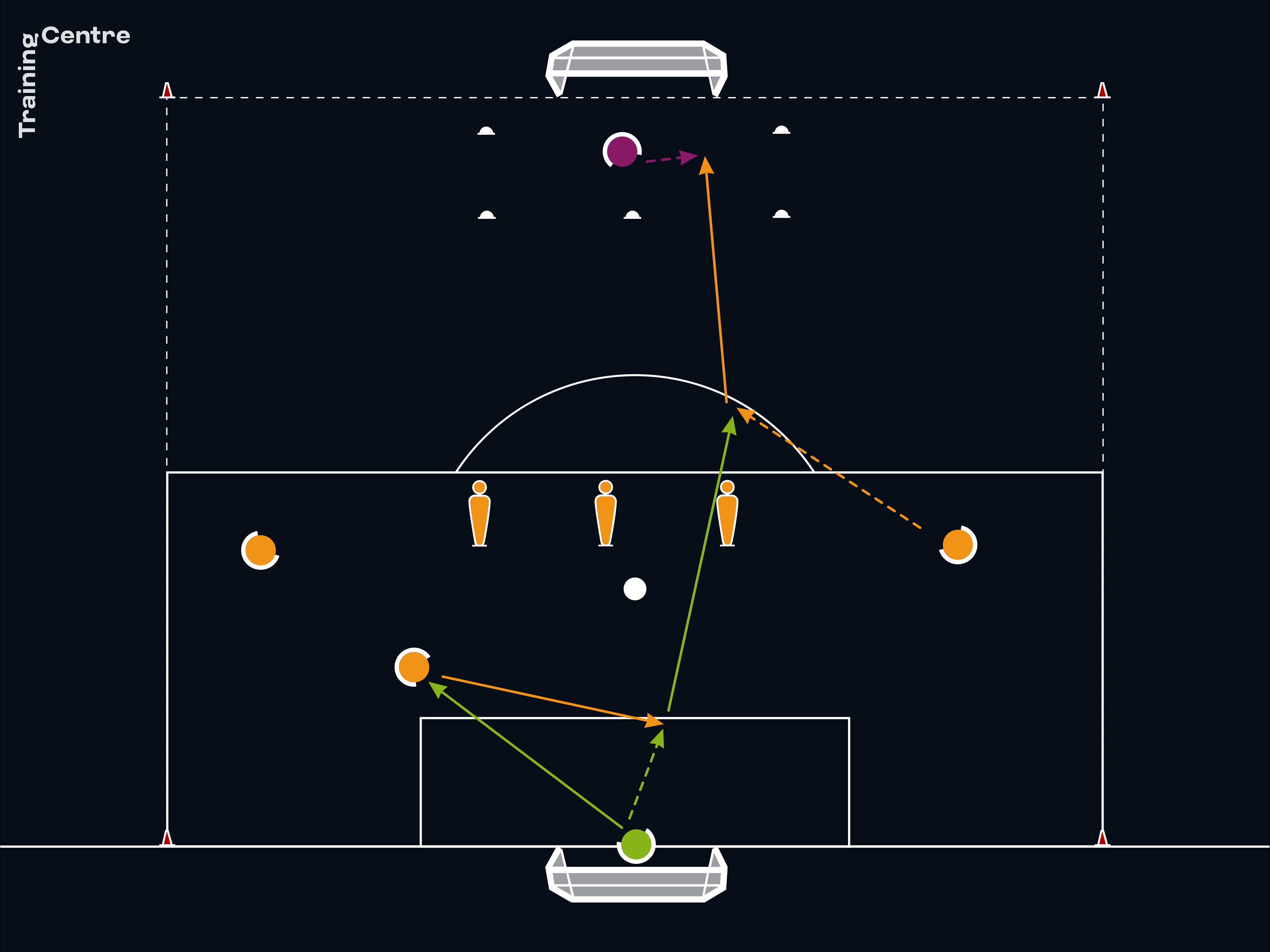
This drill focuses on how goalkeepers defend space. The idea is to create 1v1 scenarios in which the goalkeeper is forced to come out of their goal and close down the space. When closing the ball down, the defending goalkeeper has to adjust their body and look for triggers to know when to step out, thus making better decisions. At the other end of the spectrum, the goalkeeper with the ball practises short goal kicks, receiving the ball and making adjustments to play good-quality passes out from the back, as well as through the press.
-
Mark up a pitch about 25 metres in length and place a goal at each end as shown in the image.
-
Mark a line 6 metres in front of both goals to act as the goalkeeper's area.
-
Place 3 mannequins on the halfway line with space to move between each one.
-
Place a goalkeeper in each goal to defend it, with the other 2 goalkeepers taking the role of strikers. Add a support player to play with the team in possession.
-
Play starts with a goal kick from the goalkeeper: the goalkeeper plays it short to the support player, who then lays it back to set up a pass to the strikers.
-
The goalkeeper can then choose to either pass to one of the attackers for them to shoot (preferred option) or take a shot at goal themselves.
-
The strikers should play on the shoulder of the mannequins, making a run to find a 1v1 scenario against the opposite goalkeeper.
-
The opposite goalkeeper should come out and block the shot.
-
Once the ball is with the opposite goalkeeper, a transition starts and all the players switch and attack the other goal.
-
The mannequins act as the offside line and the attackers should pay attention to the offside rule.
-
1 point is given for goals scored from inside a team's own half.
-
2 points are given for goals scored from the opposition's half.
-
Add an extra player to the exercise and have them press the team in possession.
-
Alter the distances between the goals and the mannequins to either extend or limit the space.
-
Play some bouncing balls to add different scenarios.
-
The goalkeepers should make realistic movements and consider that they are taking a goal kick.
-
The initial pass should give information to the support player so that they know where to play the return pass: accuracy and the right amount of pace are crucial.
-
When receiving the return pass, the goalkeeper should create an angle that allows them to play a clean, accurate pass to a striker.
-
The defending goalkeeper should anticipate what the striker will do and focus on their run, touch or passing action.
-
If the striker shoots first-time, the goalkeeper needs to be able to get down to the ball quickly.
-
Reading cues about where the ball will be played or when the striker will shoot is something that goalkeepers need to be able to do effectively.
-
Potential action for goalkeepers to take:
- Smother
- Block
- Spread
- Reaction save (hand and foot)
Part 5: 1v1 scenarios – balls through/over from distance
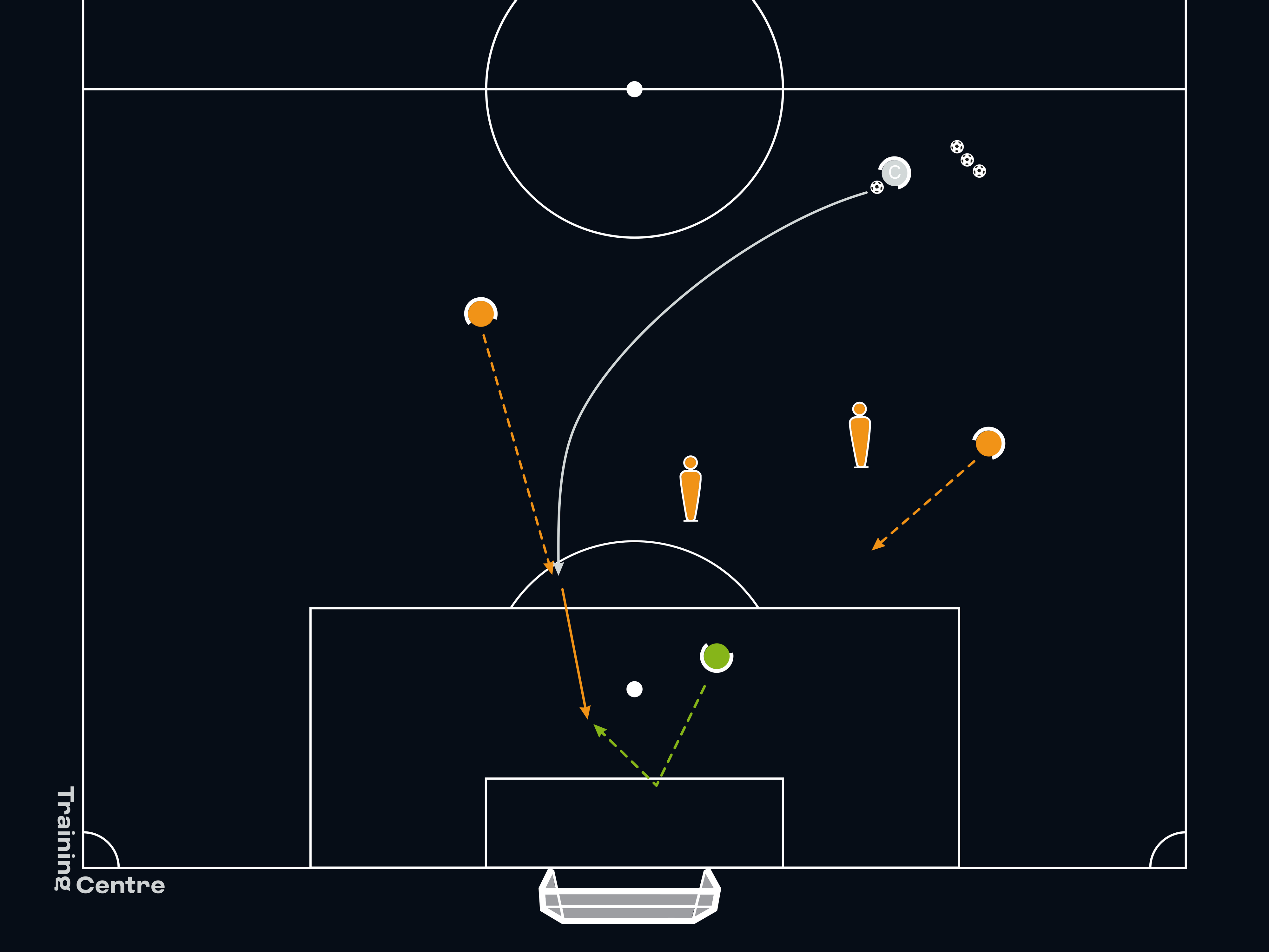
For this exercise, the goalkeepers will be given the opportunity to focus on good decision‑making (staying in a high position or retreating into their goal) during 1v1s. Some 1v1 scenarios are created in transition and when the goalkeeper has taken a high position in front of their goal. This drill puts these scenarios into practice and centres on the goalkeeper inviting the striker to come towards goal and making it more difficult for the striker to score.
-
Use half a pitch and position 1 goalkeeper in the goal, with another behind the goal ready to alternate.
-
The other 2 goalkeepers are deployed as strikers and should be ready to run at goal from distance.
-
Place 2 mannequins in front of the penalty area. Place 1 parallel to the near post and on the edge of the "D". The other mannequin should be positioned 5 metres to the right and slightly forward.
-
The starting position of the ball is just in front of the halfway line, about 10 metres infield.
-
The goalkeeper should take up a high position (close to the edge of the penalty area), as if the ball were at the other end of the pitch.
-
As soon as the coach retracts their foot, the goalkeeper should retreat into their goal.
-
The coach will play a through-ball (or lofted pass over the mannequins) into the path of one of the strikers, who should chase the ball down and run towards goal. The goalkeeper should try to prevent the striker from scoring.
-
Alternate both the goalkeeper and the striker.
-
The "striker" to whom the ball is not played can act as a defender and chase the other striker to support the goalkeeper and try to prevent a goal.
-
Add mannequins or adjust their position to create different angles or distances.
-
Set a time limit within which the striker must score.
-
Decision-making is important for the goalkeeper: they need to know when to stay high and when to retreat.
-
The goalkeeper should invite the striker to approach the goal so that they maintain a strong position.
-
If the goalkeeper stays too high, it becomes easier for the attacker to lob them or go around them. The goalkeeper should make the striker's decision harder.
-
Apply the rule that the goalkeeper should be within 3 metres of the ball and the attacker, and should try to win the ball wherever possible.
-
If the attacker gets the ball caught under/between their feet, this is a trigger to get out to them.
-
Potential action for goalkeepers to take:
-
Advance to clear or collect
-
Smother
-
Challenge the striker
-
Stand and react
-



